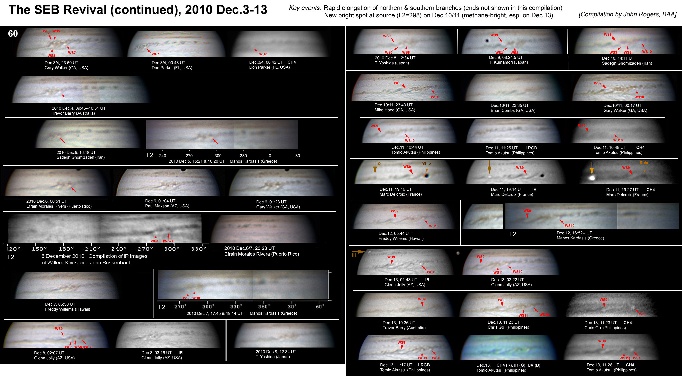
[16] The SEB revival outbreak Dec 3rd to Dec 18th ,2010.
SEB Revival update Dec.3rd -18th.
Greetings all,
Here is an update on the SEB Revival from Dec.3-18, presented in two
compilations of images, plus some initial results from the JUPOS analysis.
Congratulations to all the observers, who have provided the most thorough record
ever obtained for such an event. Please take any opportunity to observe
over the Christmas-New Year period, festivities and weather permitting, as the
outbreak is now very extensive and dynamic, and frequent observations are needed
to keep track of it.
Previously we have recorded brilliant plumes appearing at two locations: the
original source (WS1, 2, 3, 7) and the leading edge of the central branch (WS-N,
4, 5, 6). Now, brilliant white plumes have continued to emerge in both
locations: WS9 and smaller spots at the leading edge of the central branch, and
WS10 at the original source. Two other white spots have arisen in between
them (WS8, WS11).
The previous plume to appear at the source was WS7, on Dec.1. It was
methane-bright on Dec.4, and visibly bright to Dec.6, but then suddenly
disappeared. On Dec.7 a new bright spot appeared p. it (WS8: L2 = 286);
but this only lasted to Dec.10.
Another very bright plume appeared at the source on Dec.10 (WS10: L2 = 298),
methane-bright as usual (Dec.11 & 13). Then on Dec.13 another compact
bright white spot appeared p. it (WS11: L2 = 288). WS11 was initially not
methane-bright, but was slightly so on Dec.16 (along with an extended
orange-brown strip p. it), and became brighter in both methane and visible light
by Dec.17. The evidence suggests that WS8 and WS11 were weaker than those
plumes which arose at the two principal locations, at least initially. WS8
only lasted for 3 days (there were no methane images in this interval), and WS11
was initially not methane-bright, although it became so later.
Meanwhile, in the broad diagonal band at the leading edge of the central branch,
various transient small white spots continued to appear, and on Dec.8 one of
these started to grow larger and brighter (here called WS9). By Dec.11 it was a
very large 'bay' and methane-bright, and it seemed to eddy cyclonically to
generate very dark bluish-grey oblique columns on both p. and f. sides. On
Dec.14-18, WS9 elongated rapidly eastwards, still methane-bright, becoming a
long oval which accelerated into the northern branch of the Revival - like WS-N
before it. There were other, smaller white spots on the southern border of
the leading edge - indeed, a chain of five on Dec.15, one of which then became
very bright - but I have not numbered these.
The northern branch - a narrow dark segment of SEB(N) -- reached the GRS on
Dec.11, and is continuing on past it. This preceding part has turned dark
brown, but the slightly greenish tint persists further f., giving way to dark
bluish or dark grey (and methane-dark) where it merges with the oblique dark
streaks at the p. end of the central branch.
A reddish-brown colour is still seen within the central branch, but seems to be
amorphous, adjacent to white spots, and methane-bright (Dec.16 & 17) -
suggesting that it is perhaps a diffuse high-altitude aerosol emission, rather
than a clearing in the clouds.
The JUPOS team have now completed their first package of measurements of spots
in the Revival (Hans-Joerg Mettig, Michel Jacquesson, Gianluigi Adamoli, &
Marco Vedovato). We can summarise the main preliminary results, although
details are provisional; we will post the charts and more precise conclusions
later.
The source and central branch have been analysed by Michel Jacquesson. The first
three plumes at the source (WS1, 2, 3) all appeared on the same track as former
barge B2, and in the same latitude (17.3 +/- 0.2 deg.S). WS7 appeared
slightly further north (15.8 deg.S). The plumes at the leading edge
spanned a wide range of latitudes from 14.0 S (WS-N) to 19.4 S (WS4).
Nevertheless, almost all these bright spots had drifts between DL2 = 0 and -18
deg/month (mean = -10 deg/month), with no correlation with latitude. The
outbreak behaves as a coherent whole, not following the zonal gradient, except
for those spots and streaks which break free into the northern or southern
branches.
The southern branch erupted onto the SEBs which was already marked with a 'sawtooth'
or 'wave' pattern, as described in our Report no.8. Since that report,
this pattern had resumed its original speed at all longitudes, DL2 ~ +74
deg/month, with gaps moving at DL2 ~ +136 deg/month. The first
dark spot on SEBs appeared to be a pre-existing projection which had been
darkened on passing the Revival. The JUPOS chart confirms this, and shows that
it accelerated immediately, around Dec.15, to DL2 = +132 deg/month (the peak jet
speed) then settled down with DL2 = +117 (the typical speed for jetstream
spots). Subsequent dark spots emerging from the Revival also have DL2 ~
+120. This behaviour is puzzling, because the dark spots of the southern
branch still appear to be south of the usual jet peak, and do not appear to have
formed into well-defined vortices yet; but it accords with our results in 2007,
when the earliest spots in the southern branch were also unusually south for
their retrograding speeds.
All best wishes for Christmas and the New Year.
John
_________________________________
John H. Rogers, Ph.D. Jupiter Section Director,
British Astronomical Association
jhr11@cam.ac.uk
http://www.britastro.org/jupiter/